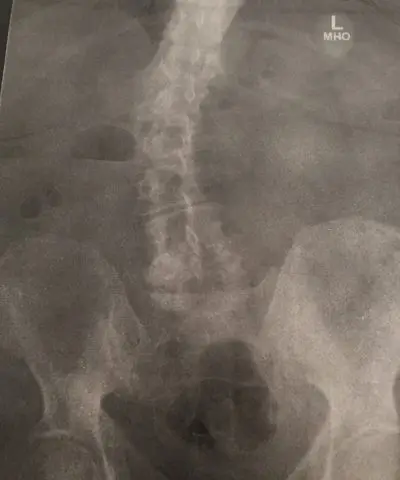This blog is part of the Analyzing Scoliosis series, which is designed to teach movement practitioners how to work confidently with clients with scoli. Previous posts have discussed the typical scoli client and adolescent idiopathic scoliosis (AIS). My book, Analyzing Scoliosis, which covers the topics in this series (as well as others) in more depth, is available on Amazon.
I previously mentioned there are several common types of scoliosis we know quite a bit about. AIS is one of them, and functional scoliosis, which I’ll cover today, is another.
Functional scoliosis is caused by tension from the muscles surrounding the spine [1]. Unlike with AIS, there usually aren’t deep vertebral rotations or genetic components involved. You’ll typically see one “C” curve in the spine, instead of two or more “S” curves like with AIS.
With functional scoliosis, a current biomechanical motion, past trauma(s), or body part is likely causing the spine to curve. Once you’re able to figure out that root cause, it’s usually relatively simple to get the spine to a more neutral position. The muscular tension around the spine simply needs to be alleviated, and the scoliosis should lessen—or even go away.
Let’s explore the causes of functional scoli a bit further and how to alleviate scoliosis in these situations.
Biomechanical Motions

What do moms with little children, hairdressers, chefs, and people with arm amputations all have in common? They all do things repetitively with one arm. In some cases, this caused their ribs to shift in one direction over time, and functional scoliosis stems from that slow shift. To decrease the scoli, the biomechanics need to be assessed in the context of the client’s repetitive actions and their non-dominant side usually needs some serious strengthening.
Leg Length Discrepancies*
A leg length discrepancy, meaning one leg is longer than the other, is the most likely culprit of functional scoliosis. If you can visually see one hip sitting higher than the other when both legs are straight on a person’s body, you’re usually seeing a leg length discrepancy. When the pelvis is off-kilter like this, the spine has to compensate by bending sideways—creating functional scoliosis.
Sometimes people are born with a leg that is a little longer that the other. Other times it can happen through a femoral break that gets set incorrectly or doesn’t heal properly. After an operation of that nature, people sometimes end up with legs that are slightly different lengths. A leg length discrepancy can even result from knee or hip replacement surgery. The surgically repaired joint ends up being ever-so-slightly longer than the non-surgically repaired side, and the pelvis gets a bit uneven to compensate. You know what happens next: functional scoliosis.
While even the best Pilates instructors can’t make uneven legs become the same length, a good Pilates instructor can use a keen eye for correct posture to catch muscular imbalances and correct them during a session. For clients with functional scoliosis, that corrective movement combined with a skilled, hands-on body practitioner to physically release the tension bound up in soft tissue around the spine and pelvis can work wonders. Give it some time, and you should have a happy and fairly straight spine. Say goodbye to that functional scoli!
So, what do you think? Would you be able to handle a client with functional scoliosis? Please share your thoughts in the comment section.
This post is part of a series for movement practitioners on how to work confidently with clients with scoliosis.
*If you think your client has functional scoli due to a leg length discrepancy, please send them to a physical therapist or orthopedist. From there, they can have their legs measured and the leg length discrepancy can be diagnosed. A shoe lift can be ordered to help correct the discrepancy, and you’ll be even better prepared to work with them now that you know exactly where their scoli is coming from.
Sources List
1 Azegami, H., Murachi, S., Kitoh, J., Ishida, Y., Kawakami, N., and Makino, M. “Etiology of Idiopathic Scoliosis.” Clinical Orthopaedics and Related Research, vol. 357, 1998, pp. 229-236.
